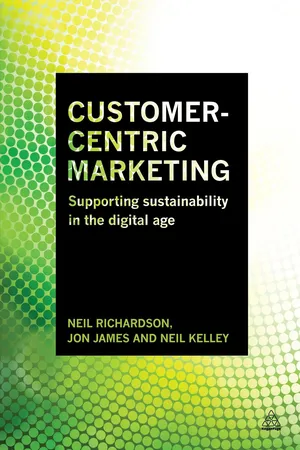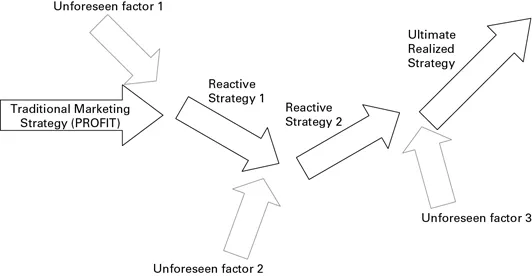![]()
Part One
Changing landscapes
Part One lays the foundations for the whole text. First, it introduces the marketing concept, before moving on to look at the notion of sustainability and how it contributes to sustainable marketing.
![]()
01
Developments in society
When considering the challenges facing your company, a key question to ask is: ‘Why would clients buy your products or services rather than those of a competitor?’ Finding good answers to such a question is crucial. One answer could be that, when buying goods online, consumers increasingly want to buy from companies which are motivated by more than ‘business-as usual’ or the traditional ‘bottom line’. Another answer could be that consumption is social, so that when ‘buying’ we take on the attitudes, beliefs, opinions and values of others. These attitudes are increasingly shaped by information shared digitally, often generated by people ‘outside’ of the companies which may suffer reputational damage and/or loss of market share. Hence companies that are unaware of changes in society run the risk of alienating customers. This is the case with sustainability which, despite being missing from most marketing texts, is increasingly important to key stakeholders.
If marketing is used and truly understood and implemented correctly in a business, it becomes a philosophy, a way of doing business – a whole approach, which should and must permeate throughout an entire organization. Hence, marketing is everyone’s responsibility not just the specialist marketers who work in the marketing department.
FAQ: Why is it everyone’s responsibility?
Well, think about it logically. How many times have you phoned an organization and been cut off or have been spoken to in an unprofessional manner or have not been given the answers you need? How often have you found a supplier’s use of technology to be intrusive? How many times have you contacted organizations as a customer and been frustrated by staff who haven’t been trained to deal with queries? Remember, not all staff are involved in sales and marketing – many are in accounts, logistics or ‘tech support’ … and yet customers don’t distinguish between the differing roles if they’re dissatisfied.
The reason marketing is everyone’s responsibility is quite simple, yet incredibly important – it’s because we all play a part in creating the ‘customer experience’.
FAQ: So, what actually is marketing?
If one word had to be chosen which epitomizes marketing, it would be the word ‘customer’. Marketing is about understanding who your customers are, being able to anticipate what they require now and in the future and, ultimately, satisfying their needs. All the work your organization (not just the marketing department) undertakes should therefore be created and implemented to delight the customer.
The definition by the Chartered Institute of Marketing (CIM) is cited widely. It describes marketing as: ‘the management process responsible for identifying, anticipating and satisfying customer requirements profitably’ (CIM, 2014).
This definition is useful in understanding the key facets of what marketing is truly all about as it is direct, concise and almost every word in the definition means something that is critical to understanding exactly what the marketing philosophy entails.
Firstly, marketing is now seen as being of senior management importance – strategic as well as tactical and operational. For it to be truly embedded into the culture of an organization, it needs commitment from ‘top’ management. In many organizations today a marketing director will be seated on the board of directors to lead the organization forward through adopting a marketing philosophy.
Secondly, marketing is an ongoing process. There is no clinical start and end. It’s neither linear nor is it a ‘one-off’. It’s continual – a process – it never stops or ends. As the world changes, so do our customers, hence our businesses adapt and evolve to move with the times.
As mentioned earlier, marketing is also about the future. Marketers must ‘anticipate’ customers’ future wants, needs and values. Why? It may take your organization years to develop a new product (or service) and launch it into the market. Therefore, you must think into the future in terms of customers’ perceptions and not just their current requirements. Increasingly, social media are being used as research tools to identify insights into how users (and influencers) see their needs changing in future.
If your organization can identify and anticipate customer requirements, you can move to try to satisfy them. But, once again, there is an added complication. Most organizations have limited resources: financial, staff, equipment etc. Therefore an organization must seek to satisfy their customers efficiently (with as little wastage as possible) and profitably! However, now more than ever, business activities should also be undertaken and managed in an environmentally friendly and socially responsible manner.
FAQ: Why focus on the customer and not concentrate on core organizational strengths?
The traditional view is that the customer purchases products and services from an organization in exchange for money. This simple exchange view is increasingly considered to be outdated. The reality is you can’t ‘give’ customers value (a mistake repeated in many marketing texts). Some argue that the exchange brings the organization and the customer together where a co-creation of value takes place. Others argue customers provide money so they can seek value from your company and your focus should be on creating circumstances where they can seek and take value. These two options (co-creation and value seeking) represent less risk for your organization as they promote a customer-centric approach. Since value seeking and taking involves bringing (at least) two parties together, a relationship is formed and many marketers today try to capitalize on that initial relationship by finding out as much as they can about the customer and their needs.
Customers are also constantly changing and technology is enabling quicker, easier decision making. For example, consider the role of cost-comparison websites such as Gocompare.com and moneysupermarket.com, which not only compete with each other but also with organizations that ‘represent’ the customer (such as Which?). As customers change, their desires, needs and wants also change and if an organization doesn’t adapt with them, the chances are that they will create dissatisfaction on the part of the customer and start to lose their customers to the competition. We call this customer attrition.
If the customer has a positive experience, they are more likely to tell their family and friends, and if they have a bad experience the chances are that they will tell even more people about it! This applies now more than ever: with the advent of Web 2.0 we’ve seen an explosion in the use of user websites (see www.imdb.com), blogs and social network sites (such as Facebook, Instagram, Pinterest, Vine etc). It is said that the one constant is change. While Facebook is still a colossus in social networking it’s questionable whether it will be so in, say, 10 years’ time. After all, how many people do you know who use Friends Reunited?
Consider the world we live in today. For many organizations, the marketplace is a difficult, dynamic, dangerous and highly competitive place to be. To be more successful, your organization must be externally focused, not just internally focused on production techniques, products and sales issues. A much wider view is needed. You certainly need excellent production techniques, products and sales initiatives but the need for awareness of the customer and other factors at play in the wider environment is paramount. Wherever and whenever you see changes in the market or environment, you must change and adapt, otherwise you risk being left behind and could therefore suffer quite serious repercussions. Many organizations suffer from this condition and develop a tunnel-like vision to their business activities. This is often referred to as marketing myopia – a short-sightedness that in this day and age can often result in the loss of customers and eventually loss of the business.
Figure 1.1 Traditional marketing strategy being deflected by emergent factors
Nowadays many academics subscribe to Mintzberg’s view that the business environment is changing at such a rate that we’re all working in permanent turbulence and our intended strategies have little chance of reaching their intended goals without deflection (Figure 1.1). Therefore the marketing philosophy must be embraced irrespective of the size or type of organization.
Example
Just think about what happened to Marks & Spencer (M&S) in the 1990s. This retail giant took its eye off its core customers whose needs were changing, the new competition that had entered the high street and the wider external environment, and, consequentially, suffered. Organizations seem to be most vulnerable after a sustained period of success. As individuals, we can become complacent when we are not challenged. It is unsurprising that organizations run by humans can react in an identical way.
Fortunately, M&S were able to make changes, which permeated to the core of their management culture and went through a process of recovery, where the focus of their philosophy changed to become one of identifying, anticipating and delighting the customer. They addressed social issues relating to supply chains and later led the way in adopting sustainable policies under their Plan A programme where they aimed for carbon neutral delivery of goods.
The rise of conflicting stakeholder interests
Increasingly, businesses have to meet rising public expectations and to address legal obligations aro...

